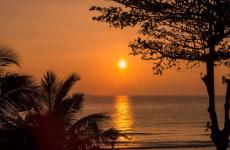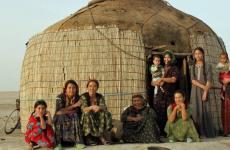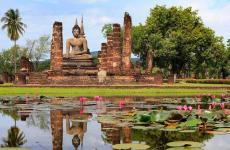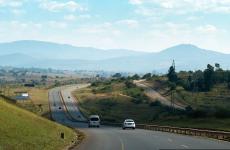Shove the stone. Mount Shunut, Sverdlovsk region
Beyond Revda, near the village of Mariinsk, there are many natural attractions. The most famous of them are Mount Shunut, the Old Man Rock and the source of St. Platonida. These places are often visited by tourists from Pervouralsk, Yekaterinburg, Revda and other cities of the Sverdlovsk region. They say it’s wonderful there!
Off-road enthusiasts drive their cars to the very foot of Shunut. And then they walk to the top of the mountain.
I always look forward to this trip, because we gather on Shunut among friends and like-minded people, tourism lovers,” says Yuri, a friend of the editorial staff of the Gorodskievesti.ru portal. He lives in Yekaterinburg and loves to travel. - Shunut means magnificent views from the top of the mountain, an interesting road that requires effort from the entire crew of the car, and, of course, an evening fire, funny conversations and stories.
Mount Shunut, or Shunut-stone- the main peak of Konovalovsky ridge. According to the portal "Uraloved.ru", Shunut is the highest mountain in the vicinity of Yekaterinburg. Its height is 726 meters above sea level.
Historians think that the name “Shunut” comes from two words: Mansi shun - “creature” and Bashkir ut - “fire”. It is possible that signal fires were once burned on this high mountain to signal approaching danger. According to another version, the ancient inhabitants of these places performed sacred rituals on the mountain.
 From the top of Mount Shunut you can see the entire surrounding area. Photo// OFF-ROAD club “Shunut4x4”
From the top of Mount Shunut you can see the entire surrounding area. Photo// OFF-ROAD club “Shunut4x4”
There is a legend about Mount Shunut. A long time ago, twin brothers grew up in these places. They often quarreled among themselves. In another brawl, one brother’s spine was damaged, which is why he remained a hunchbacked dwarf for the rest of his life. But the second brother grew up to be a giant, whose head reached the clouds. Of course, with such stature, he possessed heroic strength and defended his people from foreigners. Because he turned into a creature that spewed lightning, the giant was nicknamed Shunut.
One day Shunut became very ill. This was his punishment for ending many lives. According to legend, one of the relatives was supposed to save Shunut from suffering and kill him. Shunut had only his crippled brother left from his own blood. He agreed to the murder only on one condition - that even after death his brother would help people. According to legend, Shunut fulfilled his promise: it is believed that if you climb to the top of the mountain and “touch the clouds with your hands,” you can get rid of many diseases.
According to the same legend, Shunut lay down on the ground, his twin brother cut off his head with a sword. The severed head rolled away and turned to stone. Now this place is called the Old Stone.
 According to legends, the stone head watches everything that happens on Mount Shunut. Photo// OFF-ROAD club “Shunut4x4”
According to legends, the stone head watches everything that happens on Mount Shunut. Photo// OFF-ROAD club “Shunut4x4”
Old Man Rock located four kilometers south of Shunut. The height of the Old Man is 648.1 meters above sea level. The Old Stone got its name from its outlines that resemble a human face.
Not far from the Old Stone there is another attraction - source of Saint Platonis. This hydrological natural monument is located approximately 10-12 kilometers from the village of Krasnoyar. It is believed that the water from the source (it contains radon) has healing properties.
 Every year, hundreds of pilgrims come to the spring that flows near the source of St. Platonis for healing water. Photo// OFF-ROAD club “Shunut4x4”
Every year, hundreds of pilgrims come to the spring that flows near the source of St. Platonis for healing water. Photo// OFF-ROAD club “Shunut4x4”
There are many legends around the source of St. Platonida. According to one of them, a long time ago, a woman named Platonida from the village of Krasnoyar went to live in a deep forest. For many years she lived at the holy spring, thanks to which she managed to maintain strength and health. The spring was named in honor of Platonida. Platonida was buried there, in the forest. Pilgrims began to come to her grave.
As the second legend says, a girl from a wealthy family fell in love with a poor man. But Platonida’s father decided to marry his daughter to a wealthy peasant. Then the girl ran away from her native place and settled in the forest near Krasnoyar. At this time, her beloved was walking around the Urals in search of his bride. One day, exhausted, he sat down on the bank of a small river and turned to stone. People called this stone the Old Man. And Platonida lived for many years on the banks of the same river and secretly helped people.
 There is another belief: if you swim in the Small Ik River at the source of St. Platonida and leave some thing in which you entered the water, you can miraculously be healed of all diseases. Photo// OFF-ROAD club “Shunut4x4”
There is another belief: if you swim in the Small Ik River at the source of St. Platonida and leave some thing in which you entered the water, you can miraculously be healed of all diseases. Photo// OFF-ROAD club “Shunut4x4”
Another legend. A girl from a Tatar family decided to convert to Orthodoxy. On the eve of her wedding, she ran away and settled in a nunnery, where she received the name Platonida. With her prayers, a healing spring flowed in the forest not far from the monastery.
And the fourth legend is about the source of Saint Platonis. After the death of her parents, a girl from a family of Old Believers was taken to the forest by her brothers so as not to share the inheritance with her. After 40 (!) years, the brothers were tormented by their conscience and, considering their sister dead, they came to the monastery, where they abandoned her. There they found Platonida in perfect health, and still young and beautiful. This is because Platonida drank water and washed herself in the healing spring next to which she lived.
 Soviet films were filmed in these places. An episode of the feature film of the Sverdlovsk film studio “Golden Woman” was filmed on Shunut (it was released in 1987). And the Old Stone rock can be seen in the film “The Secret of the Golden Mountain” (1985). Photo// OFF-ROAD club “Shunut4x4”
Soviet films were filmed in these places. An episode of the feature film of the Sverdlovsk film studio “Golden Woman” was filmed on Shunut (it was released in 1987). And the Old Stone rock can be seen in the film “The Secret of the Golden Mountain” (1985). Photo// OFF-ROAD club “Shunut4x4”
How to get there
From Pervouralsk, take the Perm-Ekaterinburg highway, head towards Revda, drive through the city. One and a half kilometers before the village of Mariinsk, turn right onto the forest road. Further, if you go straight, you will get to Shunut. If you turn left, you will go to Platonida. The Old Stone rock is located between Platonida and Shunut.
Coordinates
- Mount Shunut - N 56° 31’23”, E 59° 44’09”
- Source of St. Platonida - N 56° 30’18”; E 59° 47’19"
- Old Man Rock - N 56° 29.122′ E 59° 45.346′
More on the topic
- Urban trip lovers should definitely visit. It's magical, if a little scary.
- Do you want to look at the stars and go on an exciting excursion? Then you definitely need to get into! It will be interesting for both children and adults.
Mount Shunut is a legendary place for Ural Jeepers and Nivers. Not every car can handle the road to the mountain, especially in the off-season. During the rainy season, the road, swampy in places and broken up by timber trucks, turns into an impassable path, accessible, perhaps, only to prepared trophy vehicles equipped with a winch.
However, a trip to Mount Shunut, also called “Shunut - the stone,” will leave positive impressions for many years.
Perhaps the best time to visit Mount Shunut is the beginning of winter, when the swamps and mud are already frozen, and the snow cover is not great, and allows you to move freely by car.
Mount Shunut - the highest point of the Konovalovsky ridge
The Konovalovsky Uval ridge is geographically located in the Sverdlovsk region, in the area of the villages of Mariinsk and Krasnoyar, Revdinsky urban district. The Konovalovsky ridge stretches almost along the Revda River. The length of the ridge is about 36 kilometers. The ridge is almost completely covered with forest, mainly spruce and pine.
It is believed that the name of the Konovalovsky Uval ridge is given by the name of the village of Konovalovo, nestled somewhere between the urban-type settlement of Bilimbay and the village of Krylosovo, on the continuation of the ridge line. Although, it is quite possible that this is just a coincidence...
Throughout the entire length of the Konovalovsky ridge there are numerous large and small rocky outcrops. Some of them can be easily reached, while others are blocked by marshy terrain. Driving along the ridge, somewhere in the middle of the path between the Shunut and Old Stone rocks, the road goes through the so-called “stone gates” - rock outcrops supporting the forest road on both sides.
The height of the ridge is 500 - 700 meters. The highest mountain of the Konovalovsky ridge is Mount Shunut, whose height is 726 meters.
The most famous and visited mountains of the Konovalovsky Uval ridge are Mount Shunut and Mount Starik - Stone (height 648 meters).
Description of Mount Shunut
And so, Mount Shunut, also called Shunut - stone, Shunutsky stone, is the main and most frequently visited peak of the Konovalovsky ridge in the Revdinsky district of the Sverdlovsk region. The height of Shunut is 726 meters.
The top of the mountain is crowned with rocks whose height reaches 60 - 70 meters. You can climb to the rocks along a path that can be navigated even by an unprepared tourist. During the winter season, as well as after rains, the path, due to its steepness, becomes slippery, which can make it difficult to climb.
From the top of the mountain, especially in clear weather, an excellent panorama opens up. The villages of Mariinsk and Krasnoyar are visible, and the city of Revda can be seen. The rocks of the mountain can be seen in the palm of your hand. The Old Man is a stone. Under your feet, as if from a bird's eye view, the tops of the taiga trees are clearly visible.
The age of the rocks, composed of ancient quartzite rocks, conglomerates and quartzite-sandstones, is more than 600 million years. Age corresponding to the age of the Ural Range, the Ural Mountains. The rocks from which the rocks are made are gray, less often white, and stand out as a bright spot against the background of the greenery of coniferous forests. The brightness of the rocks, especially in the summer, is added by numerous crustose (that is, almost ingrown into the rock) lichens, from gray-white to red-rusty colors.
The slopes and foot of the mountain are covered with dense, lush green taiga forest. In the winter season, especially after heavy snowfalls, the taiga, from the heights of the Shunut rocks, turns into a white sea of centuries-old trees wrapped in a snow coat.
In the old days, when local residents feared attacks, the top of the mountain was used as a sentry - a signal fire was lit on it, warning of impending danger.
Mount Shunut is actively visited by tourists at any time of the year. As a rule, a hike or trip to the mountain is combined with a trip to Mount Old Man - Stone and to. Video of a winter trip to Mount Shunut, the Old Man Stone and the source of the Holy Platonis (video from our channel Autotramp on Youtube):
In our opinion, the best time to travel to Mount Shunut is the beginning of winter, when the swamps and mud are already fairly frozen, and the snow cover is not yet very thick, which makes it possible to travel by car.
Since 1983, the Shunut mountain range, including the surrounding forests, occupying an area of about 3620 hectares, has been classified as a specially protected natural area.
How to get to Mount Shunut, GPS coordinates and track:
GPS coordinates of Mount Shunut: N: 56‘ 31.489; E: 59' 44.197.We leave Ekaterinburg towards the city of Revda, drive almost through the center of the city of Revda and drive towards the village of Mariinsk.
Before reaching 1.5 km. to Mariinsk we turn onto the Shunutsky Autobahn, which goes to the right of the asphalt road. Further along the track.
The distance from the city of Yekaterinburg to Mount Shunut is about 90 kilometers. From the village of Krasnoyar - about 10 km.
The route is designed for prepared vehicles (the roads are “broken” by timber trucks), the best option for ATVs. In winter you can ride a snowmobile.
At the beginning of winter, after the swamps and mud have frozen, but with a small amount of snow, travel to Shunut is possible with ordinary SUVs.
Note: track at the bottom of the page, saved in ".plt" format. The track can be loaded, for example, into a Garmin navigator or Navitel navigator. To download the track to Navitel, you can use our instructions: How to use the Navitel navigator. The trek includes a ride up Mount Old Man - Stone and to.
Shunut-stone (or simply Shunut) is the main peak of the Konovalovsky ridge in the Sverdlovsk region. The height of Shunut is 726 meters above sea level. This is the highest mountain in the vicinity of Yekaterinburg. The beauty of this place attracts tourists all year round.
Being the highest point of the Konovalovsky ridge, Shunut rises 726 meters above sea level.
The majestic, picturesque cliffs are in some places completely inaccessible, dropping down several tens of meters. They are especially high and steep from the east.
The rocks are composed of conglomerates - cemented pebbles - and quartzite sandstone shales. This is the reference geological section of the so-called Shunut Formation. According to geographer N.P. Arkhipov, the age of the rocks is more than 600 million years.
The surface of the rocks is covered in places with crustacean lichens of white, gray, rusty-red colors.
From Shunuta, the entire surrounding area is in full view. Below, the green carpet of taiga stretches for tens of kilometers, among which the villages of Krasnoyar and Mariinsk stand out, and further away is the city of Revda. In some places you can see the Revda River and the Mariinsky Reservoir. From Shunut you can see the trapezoidal Azov Mountain, the Falcon Stone, and on the other side the Bardymsky Range.
The surrounding area is dominated by secondary birch and aspen forests, as a result of former large-scale logging. Although there are areas with spruce, fir, and pine trees. Among the plants there are endemics and relicts, rare species listed in the Red Book.
The place is very beautiful. Therefore, it is very popular among tourists all year round. Unfortunately, ATVs and jeepers also like to come here, who have completely destroyed the road leading up the mountain. As a result, hikers walk to Shunut knee-deep in mud...
On the approach to the rocks, to the left of the path, there is a spring, but in the summer it completely dries up. So, when going to Shunut, take enough water, or collect it from the river along the way.
To the south of Shunut, along the ridge of the Konovalovsky ridge, there are low rocky outcrops along almost the entire length. But there are no roads or trails directly along the ridge. The most impressive rocks of the Konovalovsky ridge away from Shunut are the Old Stone, right at the foot of which the road passes. A separate article on Uraloved is devoted to the old stone. Another very beautiful rock is located between the Old Man and Shunut. In profile, it also resembles a human face (in my opinion, the most picturesque of these rocks). And southeast of the Old Stone is the Grandfather Stone rock. When visiting Shunut, you should definitely visit the famous radon spring with the grave of the holy hermit Platonida for the Old Believers.
The Serga River originates not far from Shunut. By the way, the Olenyi Ruchi natural park, currently stretching along this river from the city of Nizhnie Sergi and almost to Mikhailovsk, is planned to be expanded in the future and include Shunut.
Several years ago, a hermit lived in these places, partially paralyzed after a tick bite. He recently left these places, but his unfinished hut remained in the forest.
The village of Krasnoyar, from which they go to Shunut, is very small, with a permanent population of less than two hundred people. Many Old Believers of the Chapel Concord live here, who did not stray from their faith even in Soviet times. It is interesting that in the summer of 1981, members of the archaeographic expedition of USU A.A. Grinenko and I.A. Shumkov, one of the village residents, Abram Semenovich Shchukin, had unique ancient books from the 17th-19th centuries. He donated some of the books and manuscripts to USU.
Mount Shunut
This is the second part of our bike trip. Read the beginning of the story on the page “Platonida"
Mount Shunut (Shunut-Kamen) is the highest in the vicinity of Yekaterinburg, height is about 725 meters, length is about 15 km. It is the highest point of Konovalovsky Uval. The height of the rocks is from 25 to 70 m. The slopes of Shunut are covered with coniferous forest, only a few peaks are open. If you don’t know the landmarks, Shunut is not easy to find - it is practically invisible from the surrounding area, but several roads lead to the mountain.
You can get to the rocks from different directions: along a dirt road from Mariinsk, along a forest road from Krasnoyar, or from Verkhniye Serega. Shunut is very popular among tourists. At the top of the mountain there are picturesque meadows, there is a spring, and a beautiful view opens from the rocks. The small river Kozya originates from Shunut, forming the Kozinsky pond in the village of Verkhnie Sergi.
The name Shunut is presumably derived from the Kalmyk words shun - creature and ut - fire. Probably, at the top of the mountain, as the highest point, fires were often lit - for ritual purposes or to warn of danger. Also the Kalmyk name of the rivers flowing in the vicinity of Shunut is Ik (Small and Big Ik). In former times, in the vicinity of Mount Shunut, Starik-kamen, Azov there were settlements of Old Believers. In the deep forests there were their secret hermitages, into which inconspicuous paths led.
The legend of the mountain tells of the giant Shunut, whose head was cut off and now forms the Old Stone Rocks (sometimes called Shunut's Head). Between them and the top of Shunuta another group of rocks is visible, quite high, and much less visited by people due to the lack of roads. You can read about the trip to the Old Stone on the corresponding page of this site.
Mount Shunut by bike
We cheerfully set off along the path that led to the left, although Shunut was to the right. I walked first, and I was lucky to see a large hare darting away from us into the forest. After 500-700 meters, in the middle of the forest, we saw a wooden house, it seemed a little unfinished, but quite large. In front of the house there was a kind of courtyard, there was a fire or hearth burning, some kind of samovar with a pot on top was boiling, various things were laid out. Even the camp shower was suspended from the wood. And all this in the forest, among the trees.
As soon as we came closer, an old man’s voice was heard from the top floor of the house: “Where are you going?” and we saw a grandfather with a very colorful appearance: all gray, his hair had not been cut for a long time, a checkered shirt, old trousers, and one hand, apparently not works - paralyzed. We began to ask the old man whether we were going to Shunut correctly, but instead of a clear and direct answer, he spoke some kind of nonsense. That no one has gone to Shunut this year yet, that there is no path, then - that it is overgrown with grass and we cannot find it on our own, and so on. Then the grandfather began to get ready to come with us - he laced up his sneakers. For some reason I didn’t really want such a companion, after five minutes his chatter gave me a headache, I suggested walking along one of the paths marked with colored candy wrappers glued to the trees. The old man exclaimed with joy - well, we immediately went the wrong way! I'll accompany you anyway. And we went together.
The path actually went through quite thick and tall grass, but was perfectly visible. In addition, the candy wrappers prevented her from being lost. In one place, from the slope of the Shunut spur, a view of the mountains lying in the distance opened up - Azov, Markov Kamen, Sokoliny Kamen, and others. Along the way, our guide spoke incessantly: we learned that his name is Vladimir, he is a pensioner, he was a master at a vocational school, and now he lives in this wilderness completely alone, and cooperates with the Mariinsky forestry, sort of watching the trail, gluing candy wrappers, driving Tourists are shunned. At the same time, in his stories, his wild imagination was overflowing - he reported that he was forced to work by force, threatening to tear his head off, money and clothes were regularly stolen, and tourists were simply rampaging, especially 15 people from the Institute of Communications from Yekaterinburg - they tried to crush him with a motorcycle. Then it turned out that they were girls with two teachers. And many more fables. It was clear that living alone in the forest did not do him any good and had a bad effect on his grandfather’s mental health. I felt sorry for him.
Then the path became difficult to distinguish in the thick grass, but even without a guide we would have found it, we just had to look carefully at the trees where the candy wrappers were. Where the path came out onto a forest road, the old man said goodbye to us and turned back - otherwise, he said, the road was dirty, why would I drag myself there. Along the road (and indeed a rather muddy one), we quickly reached the top of Mount Shunut, and the path was quite flat; apparently, we had climbed to the required height even earlier and gradually. We passed a magnificent large clearing, overgrown with tall flowering grass - yarrow and sorrel, spreading a dizzying aroma.
Rocks were visible among the firs and pines. Further along the road on the left there was a spring-well, equipped and even with a book of reviews (on the way back we made a note there). We took pictures near a picturesque cliff hanging over the road. And then the top of Shunut appeared. There were several tents under the rocks, things were lying around, a boy came out to meet us, we greeted him and he showed us which way was better to go up.
The climb was not difficult, and soon we were already standing on one of the peaks of Shunut and contemplating the surroundings. It was visible far away, right up to the horizon in all directions; the weather was good. It was possible to observe Mariinsk and some other villages, perhaps Revda, Krasny Yar, Verkhnie Sergi. Of course, they also took photographs, then Alexander climbed the neighboring peaks, then all together - to the highest one (young people were sunbathing there). Then we had a snack and headed back to have time to prepare lunch. We walked along the road, not along the path. It led quite steeply down, was shady and full of deep ruts. And every 300-400 meters there was a motorcycle standing on it. We counted four of them in total. So in the local forests you can collect not only mushrooms and berries, but also equipment.
We went out to the place of our yesterday's dinner and went to Platonida. On the way, we stopped by the old man again, thanked him for his help and gave him money (he refused, saying that there were people all around and they would take his money away, but we still left the bill on the rubble). Along the road there were a lot of mushrooms - redheads, porcini mushrooms. It was really a shame that they couldn’t be brought home, otherwise I, a mushroom maniac, would have collected a lot of them. On Platonida, Gosha and I got busy making a fire and preparing rice porridge with stew, and Alexander began taking photographs of the spring, the river, the graves, and the altar.
While we were having lunch, the same motorcyclists whose vehicles we had found on the road from Shunut appeared next to our clearing. Since we had to decide which road to get out of here, Alexander asked them how they arrived. It turned out to be on the road leading through Old Stone to Lavrovka and Polevskoy, but the road was in the same condition as ours, and in one place for a kilometer there was just a swamp where they dragged motorcycles on their hands. In addition, the journey is much further than to Mariinsk.
Gosha rode my bike (so as not to unload his own) for reconnaissance along the trail to Krasnoyar, everything turned out to be bad there. Therefore, he really wanted to go along the road to Polevskaya. But I understood that I couldn’t do such a path, especially in one evening. This means that you will have to spend the night in the swamp. In short, Alexander and I began to convince Gosha to return along the road we knew, albeit terrible, but definitely passable and we know how long. Georgy was angry. He didn't want to wait again while I trudged along on foot. But in the end, he came to terms with it.
At eight in the evening we set off on our way back. At first, as agreed, we drove within sight, but after a few kilometers Gosha surprised us - he took off in such a way that he quickly disappeared from sight. Therefore, we overcame this nightmare together, I helped Sasha pull out the bike in particularly difficult places, every 10 minutes I again smeared it against mosquitoes, in short, we drank again to the point I didn’t want to. Alexander got both feet wet in the local puddles.
About Georgy, Alexander decided that he left us and went home alone, without even warning us. I doubted it. I thought that he simply did not want to trudge through such places slowly. In general, this is how it turned out. When there were a couple of kilometers left to the road to Revda, Gosha appeared ahead, he was driving to meet us. It turned out that he had reached Mariinsk and scouted out where he could wash and spend the night. Although, of course, that’s not how it’s done... Together we reached the road, and on the way we met a herd of horses, their leader stood in the middle and snored eerily at us, trying not to miss us. We decided to spend the night on the opposite bank of the Mariinsky Reservoir.
Having driven through the village, already at dusk we found a place on the shore in a pine forest, where there was a good descent to the water. We quickly set up the tents, and I went to wash myself. On the beach I undressed, put on a swimsuit and noticed that I had a tick embedded in my right shoulder again. In addition, a second tick was crawling on the shirt. I drowned him. Then I took a swim. I come out of the water, and Alexander comes from the tents and waves his hand - also a tick. Here we repeated the entire procedure for removing animals using a flashlight. We stored the ticks in separate pieces of paper, Sasha’s and mine, so that in the city we could have them analyzed to see if they were sick with anything. Then the guys washed up, and in the dark I collected firewood, made a fire and put the pot on. We had dinner and drank tea very comfortably, there were no mosquitoes, the fire was shining, we remembered Platonida, Shunut, the old man of the forest...
We slept wonderfully that night, only the dogs in Mariinsk barked for a long time, and Alexander was fiddling around - apparently overcoming the mud along the road, in his sleep. Early in the morning there was a slight thunderstorm and rain. Sasha woke me up before the rain and asked me to properly cover my things with an awning. I also hid the firewood under the awning. But when I left the tent at about nine, it was almost dry around, either there was light rain, or the pine trees sheltered us. In general, we calmly lit the fire and had breakfast. The place was very beautiful, and there were also mushrooms. While I went to look for them, Gosha washed his bike. We got ready, drove to the dam, where Sasha and I also washed our bikes, and moved along the road to Revda.
The road was very picturesque: sometimes you could see the river, sometimes fields, sometimes forests, sometimes villages. Beauty! There are almost no cars, driving is a pleasure. On the way, at the entrance to Revda, we had lunch. Revda turned out to be a long city; it took us a long time to get to the station. Surprisingly, the air immediately after entering became similar to city air - dusty, stuffy and nasty, that’s what industry means. We arrived at the station five minutes after the train left for Yekaterinburg, we had to wait another hour. While we were sitting, Alexander was talking into a tape recorder about our journey. And sitting on his backpack, moving its whiskers, was a huge longhorned beetle, or squeaky beetle. He sat for a long time, until our departure. We boarded the train and an hour later we were already in Yekaterinburg, where we went home, agreeing to call each other to organize our next joint trips.
How to get to Mount Shunut
From Yekaterinburg you first need to get to Revda. If you are by car, in Revda you need to move south along the street. Gorky and further to Mariinsk. If you have a car prepared for off-road use and are not averse to taking risks, then turn right before Mariinsky. And along this broken road you move 13 kilometers until you turn right. Leave the car there and another 3 km. up the mountain on foot. If the car is stuck, return to Mariinsk and look for the tractor driver. He knows what to do.
If you are on foot, then take the train to Revda, then either directly from the railway. There is a bus from the station to Krasnoyar, but they run a couple of times a day and the schedule is inconvenient. Or take a local bus to the State Farm stop. And there you vote on the highway. This bus may also have to wait. If your legs are good, you can walk the entire Revda, it’s 4 km, and vote there. You need to go to Krasnoyar.
There are two options from Krasnoyar. The first one is along Green Street, and then along the path into the forest. This trail will lead you to a dirt road, which is 5 km from Mariinsk. Along the dirt road to the left and until you turn right to Shunut, another 6 km. And there are 3 km. uphill.
Second option. In Krasnoyar, move further, through the so-called “Ancestral settlements”, to the Bolshoi Ik river. Before the river, turn right into the fields, and after about 6 km. the path leads to Platonida. Well, then go to the dirt road, along it for 2 km. until the turn to Shunut, and there it is 3 km. through the forest. Everything seems clear, if anything, call.





